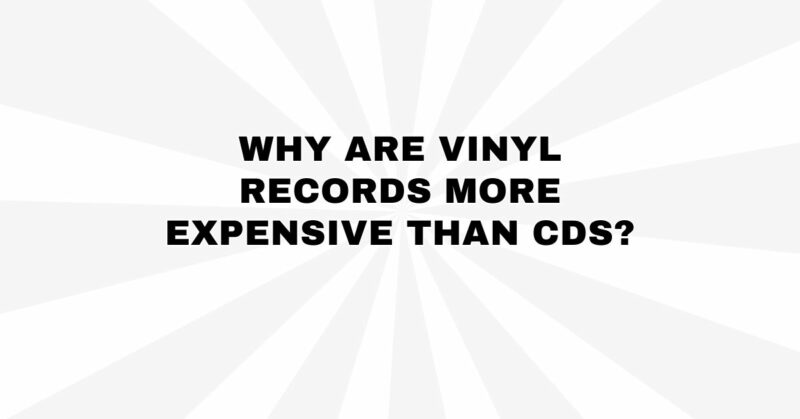In an age dominated by digital music streaming and compact discs, vinyl records have staged a remarkable comeback. Audiophiles and music enthusiasts are increasingly drawn to the nostalgic charm and warm, analog sound of vinyl, making it a thriving niche market. However, one question that often arises is why vinyl records tend to be more expensive than their digital counterparts, CDs. To understand this pricing disparity, we need to delve into the factors that contribute to the cost of vinyl records.
- Production Process:
Vinyl records are manufactured using a fundamentally different process than CDs. Vinyl is an analog format, which means that the music is physically etched onto a vinyl disc. The production process involves cutting grooves into a lacquer-coated aluminum disc, creating a master disc, and then using it to produce the vinyl records. This process is labor-intensive and requires skilled technicians and specialized equipment, all of which contribute to higher production costs.
In contrast, CDs are mass-produced using a digital encoding process, where the music is translated into a series of 0s and 1s and then stamped onto a plastic disc. This automated process is more cost-effective and efficient, resulting in lower manufacturing costs.
- Limited Production Facilities:
The resurgence of vinyl records has led to an increased demand for vinyl pressing plants. However, there are still significantly fewer vinyl production facilities compared to CD manufacturing plants. The limited capacity of vinyl pressing plants means longer lead times and potentially higher costs due to increased demand and competition for pressing slots.
- Raw Materials:
Vinyl records are made from PVC (polyvinyl chloride), a type of plastic. The cost of PVC has risen in recent years due to fluctuations in oil prices and environmental concerns related to plastic production. These factors can contribute to higher raw material costs for vinyl records.
On the other hand, the materials used to make CDs, such as polycarbonate plastic, are less expensive and more readily available. This difference in material cost further contributes to the price gap between vinyl records and CDs.
- Artistic Packaging:
Vinyl records often feature elaborate and artistic packaging, which can include gatefold sleeves, custom artwork, and other collectible elements. These added features contribute to the overall cost of vinyl production. Many vinyl enthusiasts appreciate the tactile and visual experience of vinyl records, and this premium packaging is part of what makes vinyl a unique and cherished format.
CDs, on the other hand, typically come in standard jewel cases with minimal packaging variations. This simplicity in packaging helps keep CD production costs lower.
- Limited Pressings and Collectibility:
Many vinyl releases are limited editions or special pressings, which cater to collectors and enthusiasts. Limited pressings can drive up the price of vinyl records due to their scarcity and desirability. Collectors are often willing to pay a premium for rare and collectible vinyl records, further increasing their market value.
CDs, by contrast, are typically mass-produced, and limited editions are less common. This mass production results in lower per-unit manufacturing costs for CDs.
- Audiophile Appeal:
One of the main draws of vinyl records is their perceived superior sound quality. Audiophiles often argue that vinyl offers a warmer and more natural sound compared to digital formats like CDs. This audiophile appeal can justify higher prices for vinyl records, as enthusiasts are willing to invest in a format that delivers a premium listening experience.
- Supply and Demand:
The resurgence of vinyl has also led to a surge in demand. Vinyl records are not just a medium for listening to music; they are also collector’s items and pieces of art. The intersection of nostalgia and the desire for a tangible music format has created a strong demand for vinyl records, which can drive up prices.
In conclusion, the higher cost of vinyl records compared to CDs can be attributed to a combination of factors, including the labor-intensive production process, limited production facilities, higher raw material costs, artistic packaging, limited pressings, collectibility, audiophile appeal, and supply and demand dynamics. While vinyl records may be more expensive, many music enthusiasts find the investment worthwhile for the unique and immersive experience they offer. As long as there is a demand for the warm, analog sound and collectible nature of vinyl records, they are likely to remain a cherished and sought-after format in the music industry.

